One day cycling down the Ebbw Fach valley.
With the threat of a third weather front from the ‘Beast from the east’ bringing snow and minus temperatures over Easter, today we were taking advantage of the mild conditions to cycle down another Welsh valley; the Ebbw Fawr valley. Unfortunately the town at the top of that valley (Brynmawr) doesn’t have a railway station anymore, Ebbw Vale terminus is the nearest railway station, but it's over the other side of a mountain. Ebbw Vale is 900 feet above sea level and is always 2°C colder than Newport and when we stepped off the train it was true to form; a cold 7°C, and cloudy.
Ebbw Vale to Newport via Brynmawr (30 miles)
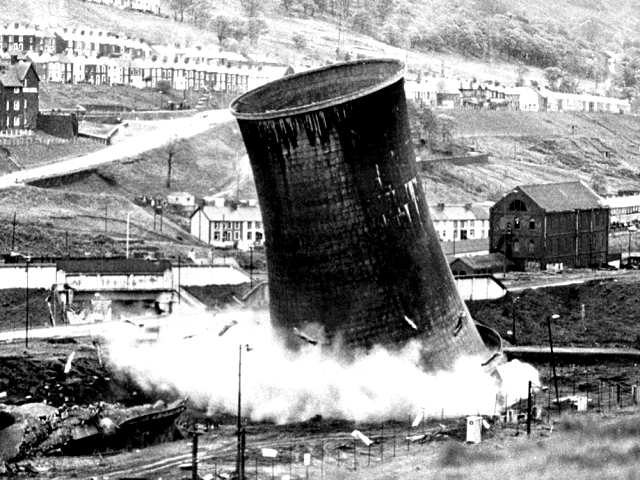 Though Ebbw vale isn’t our intended start point, it deserves its own mention; the town
began its life as an iron works, which later transformed into the largest steelworks in
Europe, only closing in 1978 (the tinplating and galvanising works lasted until 2002). It took
until 1981 before demolition and clearance of the former iron and steel plants were completed.
As a token gesture to the demise of the community- the 'National
Garden Festival of Wales' later occupied the derelict land for a short while.
Though Ebbw vale isn’t our intended start point, it deserves its own mention; the town
began its life as an iron works, which later transformed into the largest steelworks in
Europe, only closing in 1978 (the tinplating and galvanising works lasted until 2002). It took
until 1981 before demolition and clearance of the former iron and steel plants were completed.
As a token gesture to the demise of the community- the 'National
Garden Festival of Wales' later occupied the derelict land for a short while.
Just outside the station is the magnificent General Offices of the former Steelworks,
it now houses Ebbw Vale Works Museum, which has very good reviews. It was time to leave
Ebbw Vale, we ascended over the Mynydd (mountain in Welsh) Carn-y-cefn on an old
bone-shaking byway exposed to the tempestuous elements, eventually reaching Brynmawr, cited as the highest town in Wales.
Brynmawr was another town that grew up from a local ironworks- The Nantyglo ironworks.
We plodded down ‘Golf road’ and past a small pond into the town centre of Brynmawr to
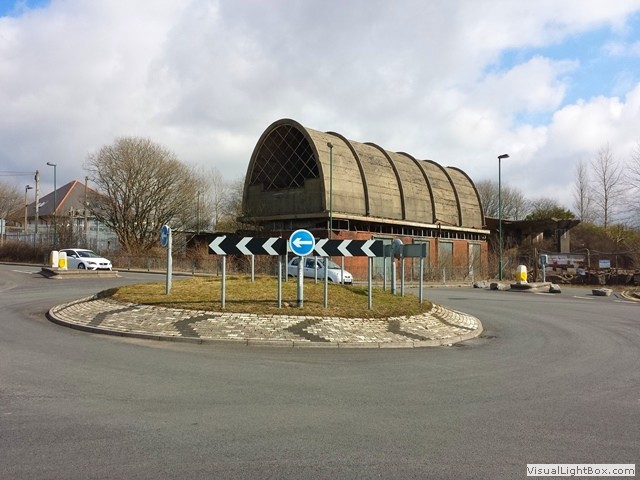 catch a glimpse of the last remaining building of the Dunlop semtex factory. It was
originally built for the 'Brimsdown Rubber Company' and mainly produced tyres. The
factory was considered by many as a modernist icon and an exemplar of the 'Festival
of Britain' period architecture (1950's), but despite being listed, it
was demolished in 2001. From here, the ‘Google’ cycle path would have you cycling down the
A467, but if you do, you will miss out on the round towers at Roundhouse Farm, built
by industrialists Crawshay and Bailey (who owned the ironworks). After the roundtowers, the road deteriorated
to a farm track, it was coarse, wet, and uneven until we reached the A467.
catch a glimpse of the last remaining building of the Dunlop semtex factory. It was
originally built for the 'Brimsdown Rubber Company' and mainly produced tyres. The
factory was considered by many as a modernist icon and an exemplar of the 'Festival
of Britain' period architecture (1950's), but despite being listed, it
was demolished in 2001. From here, the ‘Google’ cycle path would have you cycling down the
A467, but if you do, you will miss out on the round towers at Roundhouse Farm, built
by industrialists Crawshay and Bailey (who owned the ironworks). After the roundtowers, the road deteriorated
to a farm track, it was coarse, wet, and uneven until we reached the A467.
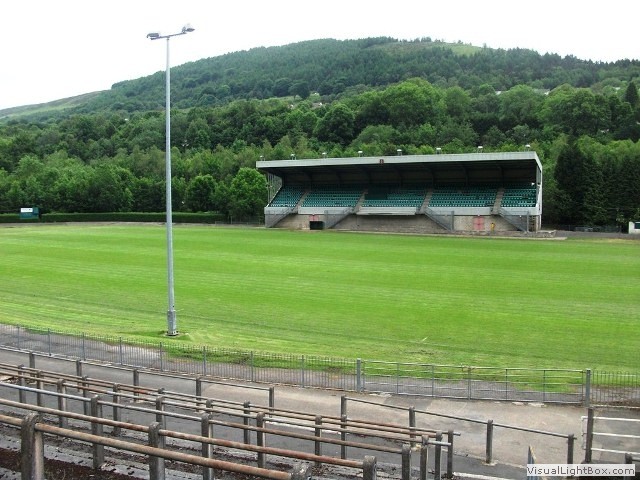 It began to drizzle heavily when we crossed the main road and onto Queens street following it through
Blaina where, we then cross the main road again to cycle through ‘Duffryn park’ crossing the
Ebbw Fach River. The path becomes soggy surrounded by trees who discarded their leaves months ago, but the babbling river is
never far away. We pass through Abertillery rugby ground which had a velodrome surrounding
the pitch, now unused (click the image for an aerial view). The next community we pass
through is ‘Six bells’ where in 1960 an explosion killed 45 miners in the local pit, the
monument to the tragedy is certainly impressive, it's a sixty six foot collier standing on the other side of the valley,
called ‘the Guardian of the Valleys’. It's now through Aberbeeg which sits on
the confluence of the Ebbw and Ebbw Fach rivers, it's then through Glandwr and to Llanhilleth. A
pinnacle of the industrial age is the workmans institute's, these ‘stuts’ soon became
the heart of every mining community used as meeting places, educational sites, and entertainment
venues. The Llanhilleth Miners Institute was built in 1904 of grey Pennant stone, with extensive red brick detail
and even had a basement swimming pool. Many 'stuts' were left to rack and ruin after the
decline of the mining industry. Llanhilleth Institute was reborn in 2007 with a £2
million revamp, we had a nice coffee there and moved on. Just down the road and hidden in a
small wood is Llanhilleth colliery winding wheel monument and pit head baths (on the other
side of the road). The baths aren’t specifically architecturally important and the locals want
rid of them. So yeah, knock them down, all they are now is a practise canvas for pyromaniacs
and vandals.
It began to drizzle heavily when we crossed the main road and onto Queens street following it through
Blaina where, we then cross the main road again to cycle through ‘Duffryn park’ crossing the
Ebbw Fach River. The path becomes soggy surrounded by trees who discarded their leaves months ago, but the babbling river is
never far away. We pass through Abertillery rugby ground which had a velodrome surrounding
the pitch, now unused (click the image for an aerial view). The next community we pass
through is ‘Six bells’ where in 1960 an explosion killed 45 miners in the local pit, the
monument to the tragedy is certainly impressive, it's a sixty six foot collier standing on the other side of the valley,
called ‘the Guardian of the Valleys’. It's now through Aberbeeg which sits on
the confluence of the Ebbw and Ebbw Fach rivers, it's then through Glandwr and to Llanhilleth. A
pinnacle of the industrial age is the workmans institute's, these ‘stuts’ soon became
the heart of every mining community used as meeting places, educational sites, and entertainment
venues. The Llanhilleth Miners Institute was built in 1904 of grey Pennant stone, with extensive red brick detail
and even had a basement swimming pool. Many 'stuts' were left to rack and ruin after the
decline of the mining industry. Llanhilleth Institute was reborn in 2007 with a £2
million revamp, we had a nice coffee there and moved on. Just down the road and hidden in a
small wood is Llanhilleth colliery winding wheel monument and pit head baths (on the other
side of the road). The baths aren’t specifically architecturally important and the locals want
rid of them. So yeah, knock them down, all they are now is a practise canvas for pyromaniacs
and vandals.
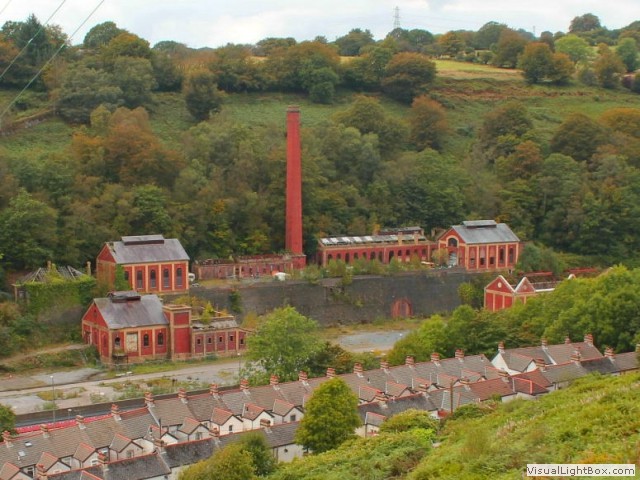 We continue uphill to Sofrydd and catch a glimpse of 'Navigation colliery' down below
us in Crumlin. Navigation was in full production by 1911 and produced coal until
1967. Currently, the disused colliery still has eleven separately listed buildings
and the site is being maintained and managed by 'The Friends of The Navigation', a
team of dedicated volunteers, with the aim of restoring the site and buildings and
bringing them back into use. We pass an abutment which used to carry the steel structure of the Crumlin
viaduct and veer left towards ‘Hafodyrynys’ and cross the A472 and proceed on a small
track for a short distance, then re-cross the main road and travel along the old
(virtually car-less) Crumlin road. To the right is a circular concrete building which used to belong to
the Hafodyrynys colliery washery, the colliery buildings have long gone, but this
building was left and is now listed. Many uses were planned for this structure, but
none came to fruition, for now it remains derelict. The whole valley was once strewn
with colliery workings, now it’s replaced by spruce trees stabilising the spoil heaps on the
steep sides of the valley, the A472 runs right through it as if the road was always there.
We soon enter Pontypool and make our way to the Pontymoel basin to join the
‘Brecon & Monmouthshire' canal, this should take us all the way back to Newport
to end the ride, but at Cwmbran the canal was blocked off. I guess I should have checked
with the ‘Canal & River Trust’ to see if it was open.
We continue uphill to Sofrydd and catch a glimpse of 'Navigation colliery' down below
us in Crumlin. Navigation was in full production by 1911 and produced coal until
1967. Currently, the disused colliery still has eleven separately listed buildings
and the site is being maintained and managed by 'The Friends of The Navigation', a
team of dedicated volunteers, with the aim of restoring the site and buildings and
bringing them back into use. We pass an abutment which used to carry the steel structure of the Crumlin
viaduct and veer left towards ‘Hafodyrynys’ and cross the A472 and proceed on a small
track for a short distance, then re-cross the main road and travel along the old
(virtually car-less) Crumlin road. To the right is a circular concrete building which used to belong to
the Hafodyrynys colliery washery, the colliery buildings have long gone, but this
building was left and is now listed. Many uses were planned for this structure, but
none came to fruition, for now it remains derelict. The whole valley was once strewn
with colliery workings, now it’s replaced by spruce trees stabilising the spoil heaps on the
steep sides of the valley, the A472 runs right through it as if the road was always there.
We soon enter Pontypool and make our way to the Pontymoel basin to join the
‘Brecon & Monmouthshire' canal, this should take us all the way back to Newport
to end the ride, but at Cwmbran the canal was blocked off. I guess I should have checked
with the ‘Canal & River Trust’ to see if it was open.
The South Wales Valleys were scattered with mines, today almost every park is sited on an old colliery, and with most collieries having their own tragedy, this was the true cost of coal. Without the monuments and chronicles, future generations have little hope of knowing their heritage. I thoroughly enjoyed this trek, and despite researching the ride, my journeys always throw up some undiscovered legacy. There’s still a lot of neglected, run down communities in the Welsh Valleys, but it is good to see at least some of the villages are recovering and honouring their past (if a little slowly, as it took 50 years to commemorate the Six Bells disaster).
-
Gallery
 Why not have a look at the gallery relating to this ride. Click the image or the title.
Why not have a look at the gallery relating to this ride. Click the image or the title. -
Ebbw Vale Garden Festival
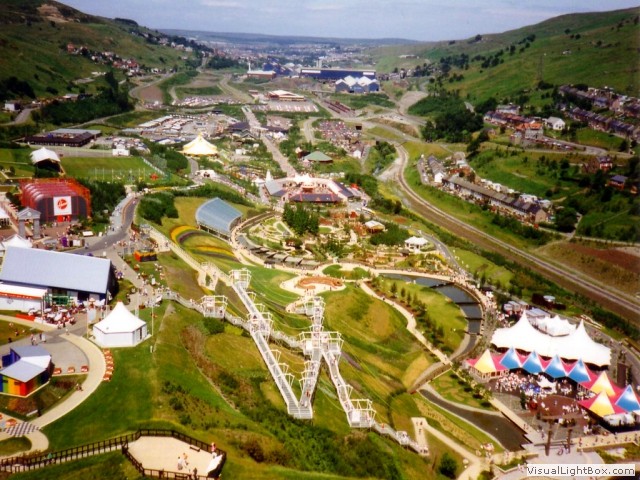 The National Garden Festivals were a high-profile 1980s initiative by the then
Conservative Government in response to criticism of their alleged neglect of areas
hit by the decline of heavy industry. The festivals were highly successful in
attracting millions of visitors, however they didn’t lead to the long-term
injection of private investment in the affected areas.
The National Garden Festivals were a high-profile 1980s initiative by the then
Conservative Government in response to criticism of their alleged neglect of areas
hit by the decline of heavy industry. The festivals were highly successful in
attracting millions of visitors, however they didn’t lead to the long-term
injection of private investment in the affected areas. -
Brynmawr roundtowers
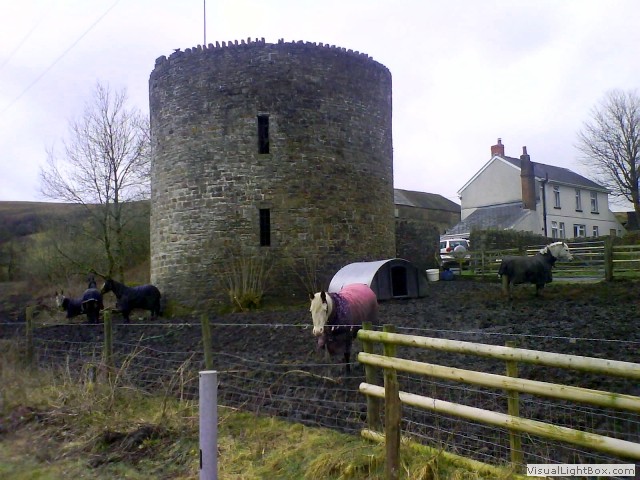 There are two fortified towers at the farm constructed in the early 19th century as
a sanctuary for the ironmaster Joseph Bailey after a riot was caused by his brother's
threat to cut wages. These were the last fortified towers built in Britain. I’ll bet the
towers cost more than the gain from the wages?
There are two fortified towers at the farm constructed in the early 19th century as
a sanctuary for the ironmaster Joseph Bailey after a riot was caused by his brother's
threat to cut wages. These were the last fortified towers built in Britain. I’ll bet the
towers cost more than the gain from the wages? -
Six Bells colliery Guardian
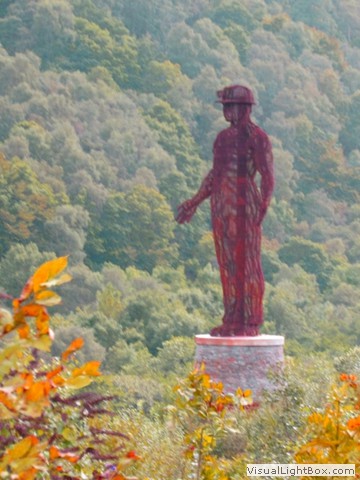 The Six Bells colliery was closed in 1988 and in 2010 the site was landscaped and
renamed ‘Parc Arael Griffin’. A 66 foot high statue called the ‘Guardian of the valleys’
was erected near the site of the old colliery to commemorate the 1960 disaster. Designed
by Sebastian Boyesen, it is fabricated with thousands of steel ribbons, his remarkable
technique allows for the incredible facial features, muscle definition and hair, clearly
visible from the path, even the trousers appear soft and flowing even though they're
fabricated from metal.
The Six Bells colliery was closed in 1988 and in 2010 the site was landscaped and
renamed ‘Parc Arael Griffin’. A 66 foot high statue called the ‘Guardian of the valleys’
was erected near the site of the old colliery to commemorate the 1960 disaster. Designed
by Sebastian Boyesen, it is fabricated with thousands of steel ribbons, his remarkable
technique allows for the incredible facial features, muscle definition and hair, clearly
visible from the path, even the trousers appear soft and flowing even though they're
fabricated from metal. -
Crumlin viaduct
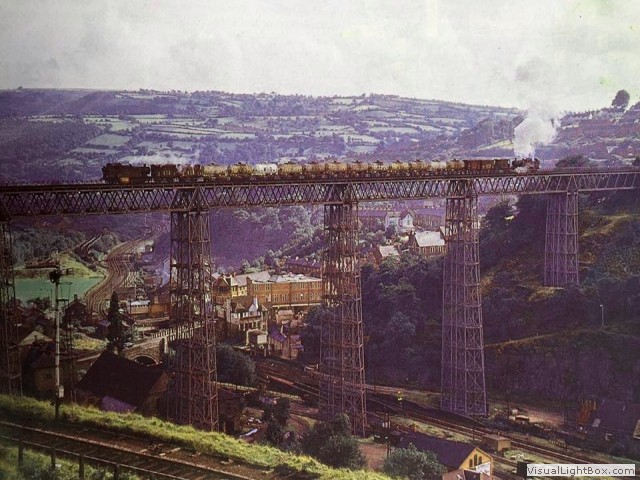 Two hundred feet above the village of Crumlin stood the Crumlin viaduct. It was hailed as ‘one
of the most significant examples of technological achievement
during the Industrial Revolution’ in its 109 years of service until being dismantled
in 1967. If it was such an accomplishment, I can’t understand why it was demolished?
Two hundred feet above the village of Crumlin stood the Crumlin viaduct. It was hailed as ‘one
of the most significant examples of technological achievement
during the Industrial Revolution’ in its 109 years of service until being dismantled
in 1967. If it was such an accomplishment, I can’t understand why it was demolished? -
Hafodyrynys colliery washery
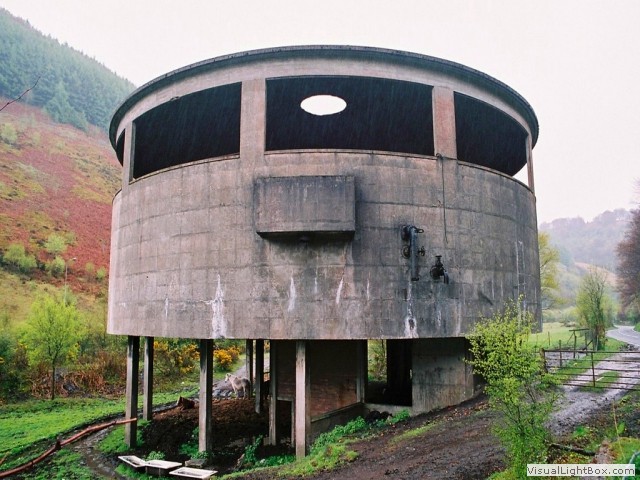 The washery contained
equipment for extracting coal dust from slurry and drying the remaining waste
before tipping; this was a revolutionary process and was rare before the 1950s.
The washery contained
equipment for extracting coal dust from slurry and drying the remaining waste
before tipping; this was a revolutionary process and was rare before the 1950s.

 The National Garden Festivals were a high-profile 1980s initiative by the then
Conservative Government in response to criticism of their alleged neglect of areas
hit by the decline of heavy industry. The festivals were highly successful in
attracting millions of visitors, however they didn’t lead to the long-term
injection of private investment in the affected areas.
The National Garden Festivals were a high-profile 1980s initiative by the then
Conservative Government in response to criticism of their alleged neglect of areas
hit by the decline of heavy industry. The festivals were highly successful in
attracting millions of visitors, however they didn’t lead to the long-term
injection of private investment in the affected areas. There are two fortified towers at the farm constructed in the early 19th century as
a sanctuary for the ironmaster Joseph Bailey after a riot was caused by his brother's
threat to cut wages. These were the last fortified towers built in Britain. I’ll bet the
towers cost more than the gain from the wages?
There are two fortified towers at the farm constructed in the early 19th century as
a sanctuary for the ironmaster Joseph Bailey after a riot was caused by his brother's
threat to cut wages. These were the last fortified towers built in Britain. I’ll bet the
towers cost more than the gain from the wages? The Six Bells colliery was closed in 1988 and in 2010 the site was landscaped and
renamed ‘Parc Arael Griffin’. A 66 foot high statue called the ‘Guardian of the valleys’
was erected near the site of the old colliery to commemorate the 1960 disaster. Designed
by Sebastian Boyesen, it is fabricated with thousands of steel ribbons, his remarkable
technique allows for the incredible facial features, muscle definition and hair, clearly
visible from the path, even the trousers appear soft and flowing even though they're
fabricated from metal.
The Six Bells colliery was closed in 1988 and in 2010 the site was landscaped and
renamed ‘Parc Arael Griffin’. A 66 foot high statue called the ‘Guardian of the valleys’
was erected near the site of the old colliery to commemorate the 1960 disaster. Designed
by Sebastian Boyesen, it is fabricated with thousands of steel ribbons, his remarkable
technique allows for the incredible facial features, muscle definition and hair, clearly
visible from the path, even the trousers appear soft and flowing even though they're
fabricated from metal. Two hundred feet above the village of Crumlin stood the Crumlin viaduct. It was hailed as ‘one
of the most significant examples of technological achievement
during the Industrial Revolution’ in its 109 years of service until being dismantled
in 1967. If it was such an accomplishment, I can’t understand why it was demolished?
Two hundred feet above the village of Crumlin stood the Crumlin viaduct. It was hailed as ‘one
of the most significant examples of technological achievement
during the Industrial Revolution’ in its 109 years of service until being dismantled
in 1967. If it was such an accomplishment, I can’t understand why it was demolished? The washery contained
equipment for extracting coal dust from slurry and drying the remaining waste
before tipping; this was a revolutionary process and was rare before the 1950s.
The washery contained
equipment for extracting coal dust from slurry and drying the remaining waste
before tipping; this was a revolutionary process and was rare before the 1950s.